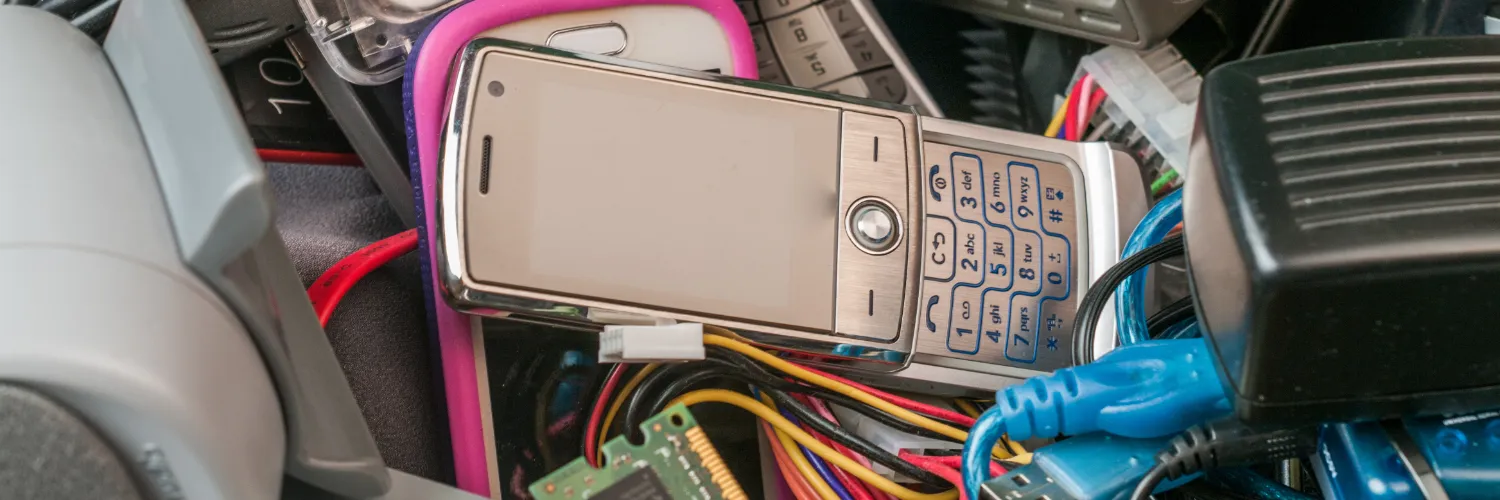E-waste hunt

Join the e-waste hunt – retrieve, recycle and revive!
Every year, October 14 is International E-Waste Day – now is the time to find your old tech and ensure it is recycled!
E-waste is a broad term, covering any kind of electronic or electrical product that has a plug or battery and that has come to its ‘end-of-life’. It includes everything from TVs, computers and mobile phones to batteries and kitchen appliances. As we all know, these electronics play an important role in our modern lives, with mobile phones and computers connecting us to friends and family, and keeping us on top of news, while everyday appliances such as toasters, blenders and washing machines keep us happy, healthy and functioning.
THE PROBLEM
Behind the convenience and ease of electronics is a huge problem: there is a global e-waste issue, with 62 million tonnes of e-waste generated globally in 2022. That is the equivalent of 1.55 million trucks of e-waste lined up and covering the length of the Equator.
WHAT IS INTERNATIONAL E-WASTE DAY?
International E-Waste Day is a global initiative run by WEEE Forum (Waste Electrical and Electronic Equipment Forum) that focuses on increasing awareness about the e-waste crisis and championing solutions to address the problems.
This year’s theme is ‘join the e-waste hunt – retrieve, recycle and revive’.
The theme focuses on the unused electronics that people store in their homes without realising these items contain valuable materials that could gain a new life. This year, the day emphasises those ‘forgotten’ items which are small electronics: old mobile phones, cables, USB keys, card readers, game consoles, and other devices that are often kept out of sight in drawers. The day aims to inspire people to declutter their homes of unused or broken devices. By doing so, everyone can contribute to pollution reduction, resource conservation, and energy and CO2 savings.
In Australia, we are big contributors to the e-waste issue, with an estimated 531,000 tonnes generated in 2020-2021. Roughly 54% of this e-waste was sent to recycling processes, recovering about 35% of the material inputs. The remainder was largely sent to landfill, where the valuable materials which are mostly recoverable are wasted! E-waste in landfill also contains hazardous materials including lead, cadmium, mercury and persistent organic pollutants. These toxic chemicals can cause serious environmental problems when they leach from landfill and pollute our soil and water, disrupting our ecosystems and health.
THE GOOD NEWS IS YOU CAN HELP TO SOLVE THIS GLOBAL ISSUE.
REUSE AND REPAIR
The best way to reduce waste is to keep your tech in use! Buy quality products which are made to last. When a part fails, have it repaired rather than buying new. You can take your broken tech to repair cafes or specialist stores for fixing around Australia. Check out the Australian Repair Network map to find a repair group near you.
DONATE OR REFURBISH
Did you know that 1 in 4 people don’t have access or the ability to engage in an online environment? Some of your old tech equipment can be donated and refurbished for use by someone else. The Reconnect Project closes the digital divide by providing people in need with good quality, refurbished technology. The Reconnect Project accepts all makes and models of mobile phones and tablets, regardless of their age or condition, and laptops that are less than 10 years old. Donate today and prevent e-waste while helping someone in need of your tech!
RECYCLE YOUR E-WASTE
We recommend using Recycle Mate to search for your nearest drop-off location where you can recycle your old tech. There are so many drop-off points, including Council Resource Recovery centres, Officeworks, various phone stores, and some Aldi supermarkets. Simply enter your address into Recycle Mate and find your nearest e-waste drop-off point.
LEARN MORE AND SPREAD THE WORD
In celebration of International E-Waste Day, we’re highlighting the amazing collaboration between Comsol and Cool.org which has resulted in the development of a suite of learning resources for secondary students called ‘Closing the E-Loop’. These learning resources are organised into two easy-to-navigate sections, free to teachers, students and anyone wanting to learn more about preventing e-waste and contributing to a circular economy for electronics!
LEARNING RESOURCES
Access the complete library of student content, teacher guides, and factsheets to discover how every action can make a difference and ensure less e-waste is produced, and more is recycled. The learning resources are centred around these four actions:
- Refuse & Rethink – Do I Need It?
- Reduce – How Can You Reduce Your Footprint?
- Reuse & Repair – Will You Repair, Reuse and Revive?
- Recycling – How Will You Close The E-Loop?
LEARNING VIDEOS
Discover the full range of Sustainable Electronics Solutions videos for expert advice on minimising e-waste both for individuals and businesses. These videos form part of the secondary school content but are also relevant for university students and adults alike.
Some highlights from this series include Comsol speaking on how their business aims to reduce environmental impact through packaging minimisation, use of recycled materials and increasing durability of their electronic products such as cables and chargers. There’s also an awesome interview with The Reconnect Project.
Check out Comsol and Cool.org’s learning resources and learning videos and spread the word.
